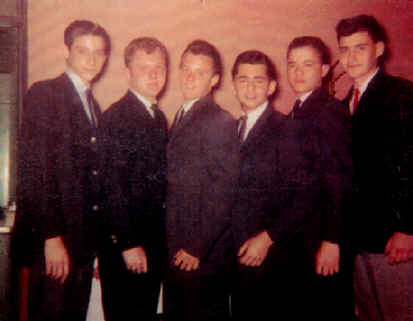
(L-R) Dennis Kestenbaum, George Kuse, John Kuse, Joel Feldman, Phil Sanchez, Chuck Epstein
The Excellents were but it didn't keep their career going when their label pulled a fast one.
The Excellents

(L-R) Dennis Kestenbaum, George Kuse, John Kuse, Joel Feldman, Phil Sanchez, Chuck Epstein
The Excellents were but it didn't keep their career going when their label pulled a fast
one.
![]()
| Members Excellents: John Kuse - lead Denny Kestenbaum - falsetto Joel Feldman - baritone Phil Sanchez - second tenor George Kuse - first tenor Chuck Epstein - bass |
Members Ultimates: Gary Allen - lead Carlos Miranda - first tenor Neil Bernstein - second tenor Donald Scheer - baritone Dave Strum - bass |
Starting out as "The Premiers","The Excellents" were first formed in early 1960. The members consisted of John Kuse-Lead and Second Tenor; George Kuse-First Tenor; Phil Sanchez-Falsetto; Joel Feldman-Baritone; Denis Kestenbaum-Lead/Baritone and Chuck Epstein-Bass. All members came from The Bronx, New York. In June 1961, they recorded "Red Red Robin" and "Love No One But You" for the Sinclair Record Corporation.
These two sides were released on Mermaid Records(a division of Sinclair Record Corp..) in late June 1961. The record received no promotion and was aired by DJ Slim Rose on his Time Square radio show heard only in the New York area. "The Excellents" signature song, "Coney Island Baby" was arranged at the time thought to be the flipside of their next release.
They had already planned on their own uptempo cover of "The Cleftones" smash hit "You Baby You" to be the 'A' side. "You Baby You" and "Coney Island Baby" were recorded in February 1962 for Blast Records (a division of Sinclair Record Corp.) and released in April 1962.
Sinclair Records started promoting "Coney Island Baby" and, it won DJ, Murray the K's 'Boss Record of the Week' contest. With prominent local concerts and a rising reputation, the Excellents looked set for a promising career until record business skulduggery intervened. Booked for an appearance on Dick Clark’s American Bandstand television programme, their record company refused to pay their travelling fees.
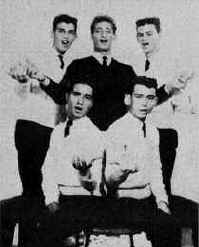
The Ultimates
When they learned that the group simply could not afford to travel to Philadelphia, the label instead sent a Brooklyn group, The Ultimates ( Envoy Records )who recorded "I Hear a Rhapsody" / "Why Did You Laugh"under the name of the Excellents .
Justifiably devastated at this turn of events, the Excellents never recorded again. In 1964, Bobby Miller, owner of Bobby and Oldtimer Record Labels, purchased and released demos "Sunday Kind of Love" and "Helene" as the Excellons.
The Fiestas
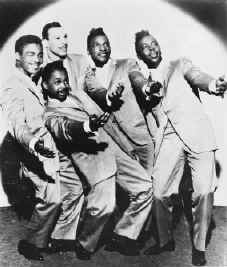
The Fiestas were important as one of the early soul groups to grow out of the '50s rhythm
and doo wop
![]()
Members:
Tommy Bullock - first tenor
Eddie Morris - second tenor
Sam Ingalls - baritone
Preston Lane - bass
The Fiestas came from Newark, New Jersey all from the same neighborhood, and consisted of members Tom Bullock, Eddie Morris, Preston Lane, and Sam Ingalls. Early on, the group practiced their songs and hoped to convince a record label that they had the stuff to produce a hit record. They recorded a demo side for Jim Gribble (who became their manager) who took the recording to various labels in New York. After a time of trial and error, they were heard by Hy Weiss the owner of Old Town Records one of the top performing New York City independent labels. He liked what he heard obviously, and soon had the group in the recording studio
.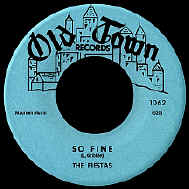
They recorded a song written by Jesse Belvin years before called "So
Fine" and also backed it with a ballad called "Last Night I Dreamed (Of
You)" and Old Town released it on # 1062. The ballad originally was targeted as the
'A' side but soon radio airplay in the New York area flipped to the medium tempo rocker
"So Fine" . Listeners were intrigued by the four part harmony throughoput the
song rather than the standard lead and backup format that was the norm for the vocal group
style. By February the group had a solid hit that was breaking out nationally. The four
part lead throughout the song was certainly catching the ear of radio listeners and the
group was now in demand as new hit makers always are.
By March the record was doing big business in the Midwest especially in Detroit and
Chicago, and was breaking big on the pop music charts. In April The Fiestas began to make
personal appearances throughout the Northeast. In April Bill "Hoss" Allen on
WLAC in Nashville picks the record as the top pick of the week. In May Johnny Otis and his
representatives filed a lawsuit over the record claiming that he was the true composer of
the tune. Named in the suit were Old Town Records, Jim Gribble, and The Fiestas
themselves. In June Eldorado Music wins the lawsuit for the interests of Johnny Otis and
the matter is settled with Old Town paying a designated sum of money and legal costs.
In July The Fiestas get around to recording a followup record for Old
Town. After a fabulous run of "So Fine", the group has "Our
Anniversary" and "I'm Your Slave" on # 1069. In October Henry Glover after
a time at King Records in Cincinnati moves to Old Town and produces a new side by The
Fiestas called "That Was Me" and "Good News" on Old Town # 1074. In
late October the group heads South for a series of one nighters. In late November The
Fiestas play the Regal Theater in Chicago for an all star R & B show headlining Ray
Charles, Nappy Brown and the Sarah McLawler-Richard Otto Combo.
Between 1960 and 1962 there were several changes in the group's line up with Bobby Moore
from the "Four Most" (1960), Randall Stewart (1961), some of the recruited
members of the group. Now as the new decade was beginning the group moved to a more
modernistic style combining elements of the blues and soul. They continued to turn out
records for another five years for Old Town before calling it quits as an act. They got in
at the tail end of the vocal group era and had one memorable hit record that has endured
through all the passing years. The Fiestas had made their mark on the history of the
music.
The Five Satins
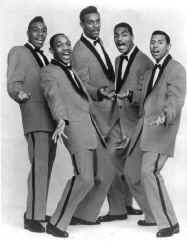
One of the greatest rhythm and blues ballads In the Still of the Night was actually only
record by four Satins.
![]()
Members:
Fred Parris - lead - replaced by Bill Baker on "To the Aisle"
in 1957
Al Denby - tenor
Ed Martin - baritone
Jim Freeman - bass
Stanley Dortch
The Five Satins are best-known for the doo-wop classic "In the Still
of the Night," a song that was popular enough to make the group one of the most
famous doo-wop outfits, although they never had another hit of the same magnitude.
The origins of the Five Satins lie in the Scarlets, a New Haven, Connecticut doo-wop group
led by Fred Parris. The Scarlets formed in 1953, while Parris was still in high school.
The group had a local hit with "Dear One" the following year. In 1954, Parris
formed the Five Satins with vocalists Al Denby, Ed Martin and Jim Freeman. Within the next
year, Parris had the group record "In the Still of the Night," a song he had
recently written, in the basement of a local church. The first single the group released
was "In the Still of the Night." The single was released on Standard Records in
the spring of 1956. By the end of the year, it had been leased to Ember and it became a
huge hit, peaking at number three on the R&B charts and number 25 on the pop charts.
By the time "In the Still of the Night" scaled the charts, Parris had been
drafted into the army. He was stationed in Japan when the song became a hit and he was
still stationed in Japan when the group recorded the follow-up single, "To the
Aisle." For that single, Bill Baker handled the lead vocals. "To the Aisle"
became a Top Ten R&B hit (number 25 pop) in the summer of 1957. Parris returned from
the army in 1958. Upon his return, he re-organized the group, adding Richie Freeman,
Sylvester Hopkins, West Forbes, and Lou Peeples. This incarnation of the group had a minor
hit in the fall of 1959 with "Shadows."
In 1960, "In Still of the Night" re-entered the pop charts thanks to its
exposure on Art Laboe's first Oldies But Goodies compilation. The repeated success of the
single sparked a another minor hit for the band in 1960 -- the group's cover of the
standard "I'll Be Seeing You" scraped the bottom of the pop charts in the summer
of that year. Early in 1961, "In the Still of the Night" entered the pop charts
again. During the remainder of the '60s, Parris led various incarnations of the Five
Satins through oldies revues in America and Europe; they also recorded occasionally during
this time. In 1970, the group appeared in the film, Been Down So Long It Looks Like Up to
Me; three years later, they appeared in Let the Good Times Roll.
In the early '70s, the Five Satins continued to play the oldies circuit under the
direction of Fred Parris. In 1974, the group signed a contract with Kirsner Records and
released a single, "Two Different Worlds." Two years later, they briefly changed
their name to Black Satin and released a single called "Everybody Stand Up and Clap
Your Hands (For the Entertainer)," which became a Top 50 R&B hit. Shortly
afterward, the group reverted to the Five Satins name.
In 1982, the Five Satins had their last hit with a doo-wop medley entitled "Memories
of Days Gone By." The single, which was released on Elektra Records, peaked at number
71 on the pop charts. For the remainder of the '80s and the '90s, Fred Parris led various
lineups of the Five Satins and the group performed regularly at oldies shows in America
and Europe. ~ Stephen Thomas Erlewine, All-Music Guide
The Flamingos

The Flamingos, 1954. Clockwise from top left: Paul Wilson, Sollie McElroy,
Zeke Carey, Johnny Carter and Jake Carey
Vocal group aficionados consider the Flamingos to be one of the best if not
the best of their era
![]()
Members:
Nathaniel Nelson - lead
John Carter - second tenor - replaced by Tommy Hunt
Terry Johnson - tenor
Ezekial Carey - second tenor - not in group 1956-1958
Paul Wilson - baritone
Jacob Carey - bass
Sollie McElroy - left 1954
Both prolific and seminal in their influence and impact, The Flamingos may
have been the greatest harmonizing vocal ensemble ever, and were certainly among the
premier units of the doo wop/R&B era. Cousins Jake and Zeke Carey moved to Chicago
from Baltimore in 1950. They met Paul Wilson and Johnny Carter at the Church of God and
Saints of Christ Congregation, a black Jewish church. They began singing in the choir, and
the foursome met Earl Lewis (not The Channels' lead vocalist) through one of the members'
sisters, who was his girlfriend at the time. They originally called themselves The
Swallows, but had to change names when they found out that a Baltimore group already had
the name. Carter suggested El Flamingos, which was changed to The Five Flamingos, and
later The Flamingos. Ralph Leon of the King Booking Agency eventually became their
manager. Sollie McElroy replaced Lewis as their lead singer in the early '50s, with Lewis
joining The Five Echoes. They recorded with Chance in 1953, and "If I Can't Have
You" attracted some attention and did well in the Midwest and on the East Coast.
"That's My Desire" and "Golden Teardrops" were marvelously sung
numbers, particularly "Golden Teardrops," with its sweeping harmonies on top and
bottom framing McElroy's wondrous lead. But none of their great Chance recordings
generated enough national attention to make the R&B charts, nor did the three numbers
they recorded for Parrot. McElroy departed and was replaced by Nate Nelson. They enjoyed
their first chart success with Checker in the late '50s, scoring a Top Ten R&B hit
with ![]() "I'll Be Home" in
1956. They temporarily disbanded in 1956 and regrouped in 1957 with Nelson, Jake Carey,
Paul Wilson, and Tommy Hunt as the lineup, and the group now a quartet. Zeke Carey
returned in 1958, and they signed with End late that year. "I Only Have Eyes for
You" in 1959 was their biggest hit, peaking at number three R&B and number 11
pop. It was a cover of a song that had been a huge hit for Eddy Duchin in 1934, and was
the start of a productive period that saw The Flamingos issue four albums for End and get
two more R&B Top 30 singles, one the Sam Cooke composition "Nobody Loves Me like
You" in 1960. Hunt left in 1961, and the group returned briefly to Checker in 1964.
They later recorded for Phillips, Julman, and Polydor, but couldn't regain their former
standing. They remained among the genre's most beloved groups, and anthologies of their
material on Chance and Checker have been reissued. In 1993, The Flamingos Meet the
Moonglows was reissued by Vee-Jay. ~ Ron Wynn, All-Music Guide
"I'll Be Home" in
1956. They temporarily disbanded in 1956 and regrouped in 1957 with Nelson, Jake Carey,
Paul Wilson, and Tommy Hunt as the lineup, and the group now a quartet. Zeke Carey
returned in 1958, and they signed with End late that year. "I Only Have Eyes for
You" in 1959 was their biggest hit, peaking at number three R&B and number 11
pop. It was a cover of a song that had been a huge hit for Eddy Duchin in 1934, and was
the start of a productive period that saw The Flamingos issue four albums for End and get
two more R&B Top 30 singles, one the Sam Cooke composition "Nobody Loves Me like
You" in 1960. Hunt left in 1961, and the group returned briefly to Checker in 1964.
They later recorded for Phillips, Julman, and Polydor, but couldn't regain their former
standing. They remained among the genre's most beloved groups, and anthologies of their
material on Chance and Checker have been reissued. In 1993, The Flamingos Meet the
Moonglows was reissued by Vee-Jay. ~ Ron Wynn, All-Music Guide
The Flamingos were inducted into the Rock and Roll Hame of Fame in 2011
The G-Clefs
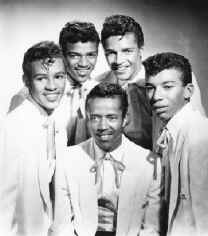
The G-Clefs 1956
Clockwise from far left
Joe Jordan, Chris Scott, Teddy Scott, Tim Scott. Ray Gipson
The G-Clefs originally began as gospel singers
![]()
The group originally were gospels singersMembers:
Chris Scott - baritone
Teddy Scott - tenor
Timmy Scott - tenor
Joe Jordan - bass - replaced by Arnold Scott
Ray Gibson - lead
Artist Biography by Joe Viglione
The G-Clefs is a highly flamboyant, well-choreographed pop/soul vocal group which has the
distinction of having the first Boston area rock & roll record to chart nationally,
their 1956 hit "Ka Ding Dong." Consisting of four brothers, Teddy Scott (b.
February 29, 1936), Chris Scott (b. February 2, 1937), guitarist Tim "Payme"
Scott (b. August 23, 1938), and Ilanga Scott (b. July 22, 1940), along with their friend
and neighbor Ray Gibson (b. September 24, 1937), the band formed in Roxbury, MA, an area
similar to New York's Harlem, thirty years before New Edition would bring Maurice Starr
and Michael Jonzun's music to the world, The G-Clefs were the original pioneers from New
England's soon-to-be-important music scene.
The Scott's gang, "The Band of Angels", ruled in what was known to the police as
"Scotty's Alley" with the warning "pass at your own risk", but the
gang of "bad boys" had their giving side donating monies to charity. The Scott
brothers' parents "adopted everyone" singer Teddy Scott told AMG in an August
2000 interview. Songs like the moody and intriguing "Zoom Gali Gali" and
"Why Can't We All Get Along" on the Then & Now CD contain biographical bits,
"Zoom" was written by Tim "Payme" Scott about when they were kids and
their homes had fenced-off back yards with alleys. The band would hold little shows
charging a penny for people to see, and with their sisters and friends, they would perform
an Egyptian act.
The band's first "official" show was circa 1952/1953 at the Rollerway, a roller
skating rink which converted to a dance hall on Fridays, located in Revere, MA. Revere
Beach in the '50s and '60s was Boston's answer to Palisades Park, the group playing
hundreds and hundreds of shows before they made it into the charts.
They recorded "Mary Lee" at Ace Recording Studios in Boston in the '50s, a cover
of the tune recorded in 1955 by the Rainbows. That 45 was brought to the band by Ted's
girlfriend Audrey Fortune. The G-Clefs then came up with "Ka Ding Dong" "in
eight minutes!" according to Teddy.
Ted Scott considers Revere "home", and at a special show on May 18, 1996 with
Moulty & the Barbarians and the Pixies Three at The Wonderland Ballroom, he reminisced
about the early days. When contacted to perform at The Apollo Theater, he said the band
couldn't sing for four days they were so frightened -- "for four days, swear to
God." The band performed so well they played that Harlem theater over a dozen times.
The group purchased The Peppermint Lounge in Revere and turned it into The Pied Piper.
There were 20 or so clubs on the strip along with the rides and amusements, but the three
performance venues were Hurley's, The Ebb Tide and, their own Pied Piper. A 1968 release
on Spotlight Records, The G Clefs Live at the Ebb Tide, is a good document of the time.
The group polished its flashy stage show doing five shows a night during the week, and ten
on Sundays when they did matinees as well. In 1997, filmmaker Abby Freedman's Redhead
Productions initiated a 90-minute documentary film titled Ka Ding Dong after the group's
first hit record. Projected to be released in 2003, there is footage from shows taped at
The Hatch Shell on Boston's Charles River and Symphony Hall, as well as rare 1963-1964
home movie footage from Hurley's nightclub on Revere Beach. Freedman told AMG that this is
one of the few groups in the U.S. with the original five vocalists all still in the band,
giving a "sense of continuous history". Backing musicians which include
keyboards, guitar, sax, bass, and drums, have changed over the years, saxophonist Dick
Lourie being the veteran -- having joined the group in 1992/1993, with guitarist Danny
Gioioso joining circa 1998.
The Genies
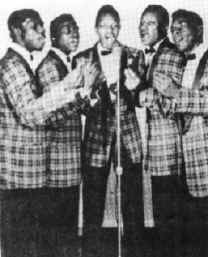
From the left:
The Genies originated in 1956 on the boardwalk at Long Beach, Long Island.
![]()
Members:
Roy Hammond - lead/first tenor
Bill Gaines - second tenor
Alexander "Buddy" Faison - baritone
Fred Jones - bass
Claude Johnson
The Genies Biography by Andrew Hamilton
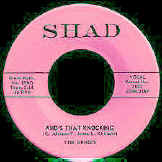
This short-term group from Long Beach, Long Island recording career lasted
three years, and five singles; they broke up a year after they started recording in 1958,
but Warwick Records issued canned material until 1961. The original members -- Roy
Hammond, Bill Gains, Alexander Faison, and Fred Jones -- formed in 1956. They didn't
record until Brooklynite Claude Johnson came aboard. Johnson, the only member not from the
Long Beach area, named them the Genies; he had sung with a Brooklyn group that included
Eugene Pitt, who never sang with the Genies. Bob Shad, the owner of Shad Records, saw them
singing on a beach and invited them to audition for his label. The result was
"Who's That Knockin'," recorded in June 1958; but Shad didn't release it until
March 1959, nearly a year later. It did well R&B but wallowed on the lower rungs of
the pop chart at number 71.
Then without warning, second tenor Bill Gains ran off to Canada with a woman and hasn't
been seen nor heard from since. This occurred while the Genies were playing their
first big engagement at New York's Apollo Theater; three days into the gig, and poof --
Gains vanished. The Genies answered their debut with "No More Knockin'" on
Hollywood Records, then the Warwick label released three singles after the group became
history: "There Goes That Train" b/w "Crazy Love," "Just Like the
Bluebird" b/w "Twistin' Pneumonia," and the best "Crazy Feeling,"
in 1961. By the end of 1959, the Genies were a memory. Hammond cut a string of solo
records as Roy C, his biggest was "Shotgun Wedding," a number 14 R&B hit.
Claude hooked with Roland Trone and enjoyed a monster number seven pop hit with
"What's Your Name" as Don & Juan. Johnson also be came a songwriter of note,
composing the Genies' debut, the Don & Juan hit, and 57 other titles registered with
B.M.I
The Harptones
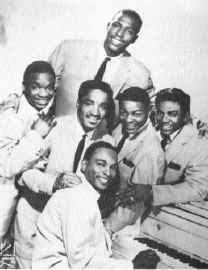
Top: Willie Winfield
Center L to R: William " Dempsey" James, Nickey Clark,, William Brown,
William "Dicey" Galloway
Bottom: Raoul Cita
A unique jazz influenced vocal group that enjoyed limited success in the
50s and early 60s. group
![]()
Members:
Willie Winfield - lead
William "Dempsey" Clark - second tenor
William "Dicey" Galloway - baritone - replaced by Jim Beckum
Bill Brown - bass
Nicky Clark - first tenor
Raoul Cita - arranger
Despite not landing on the R&B or pop charts for their entire careers, the Harptones were a superb doo wop ensemble. They initially emerged from a 1953 union of members of the Harps and Skylarks. Willie Winfield and his brothers Jimmy and Clyde first teamed with Bill Galloway and Johnny Bronson as the Harps. When Galloway sought a pianist for the Harps, he found Raoul Cita in the Skylarks. Eventually a new group with Winfield and Galloway plus former Skylarks Cita, Curtis Cherebin, and Bill Dempsey became the new Harps. Unlike most doo wop and R&B units, the Harptones (who took that name in 1953 after Bruce Records executives Morty Craft and Monte Bruce informed them there was already a group on Savoy called Little David Baughn and the Harps) were more jazz-oriented in their harmonies and arrangements, thanks to Cita. But they weren't so sophisticated that they lacked earthiness or grit, thanks to Winfield. "I Want a Sunday Kind of Love" featured Winfield's silky vocals and the group's magnificent harmonies. It was a big regional success, but never got national attention. That was the story for virtually every Harptones single.Though they were popular enough to be included in the historic 1955 Rock and Roll Ball at St. Nicholas Arena in New York alongside the Drifters, Clovers, Fats Domino, Moonglows, and Big Joe Turner, they never scored a national hit. They recorded for Essex, Old Town, Rama, Tip Top, Gee, Warwick, Coed, Cub, Comp, and Raven, among others, besides Bruce. The Harptones cut an LP, Love Needs the Harptones, for Ambient Sound in 1981. They continued playing clubs and oldies shows into the '90s. -- Ron Wynn, All-Music Guide
Lee Andrews and
the Hearts
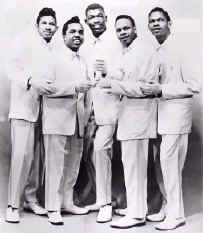
(L to R) Ted Weems, Butch Curry, Lee Andrews, Roy Cal;houn, Wendell Calhoun
While singing ar various local functions the Hearts were discovered by Barry Goldner, an
executive at Mainline Records.
![]()
Members:
Lee Andrews - lead
Roy Calhoun - first tenor
Tammery Curry - second tenor
Ted Weems - baritone
Wendall Calhoun - bass
They first got together in high school, and for a group of young black kids from 49th & Woodland in Southwest Philadelphia, music was a way out of a life of poverty. All born and raised in Philadelphia, except for South Carolina native Lee Andrews, they were neighborhood friends singing in gospel groups before uniting as The Dreams.
It was their legendary harmony and extraordinary talent that led Rory
Calhoun, Wendell Calhoun, Ted Weems, Butch Curry, and Lee Andrews in 1954 to an audition
with WHAT-AM DJ Kae Williams, and in turn to rainbow Records. the wife of Rainbow's owner
discovered a plastic heart on her desk, and accidentally found the name that would take
them to the top and change their lives.
Specializing in smooth ballads, this Philadelphia R&B vocal quintet notched three hits
in 1957-1958. Andrews formed The Hearts in 1953, and they debuted the next year on the
Rainbow label. Chess picked up their first big seller, Long Lonely Nights," from the
tiny Mainline label in 1957. Mainline also originally issued their biggest hit for Chess,
"Teardrops." Moving to United Artists, the group charted for the last time in
1958 with the typically polished "Try the Impossible." Andrews and a shifting
lineup of Hearts continued to record through the '60s. ~ Bill Dahl, All-Music Guide
The Heartbeats
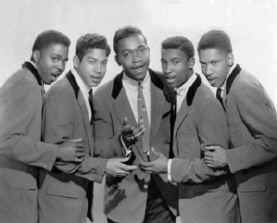
L to R: Robbie Brown, Wally Rocker James Sheppard, Vernon Seaver Albert Crump
The Hearbeats were one of the premier voacl groups of the 50s
![]()
Members:
James "Shep" Sheppard - lead
Wally Roker
Vernon Seavers
Robbie Brown
Albert Crump
Lead singer James "Shep" Sheppard co-wrote a series of velvety doo-wop ballads for The Heartbeats during the mid 50s; one entry, "A Thousand Miles Away," was a huge R&B seller in 1956. The Queens, NY, quintet began their string of street-corner classics with "Crazy for You" and "Darling How Long," culminating with "A Thousand Miles Away." The Heartbeats recorded for Hull, Rama, Roulette, Gee, and Guyden before packing it in. In 1961 the lead singer formed a new trio, Shep & The Limelites, and scored on the charts with a heartwarming sequel to his first hit, "Daddy's Home," for Hull. "Our Anniversary" also sold well for the trio the next year, but they broke up soon thereafter. Sheppard was found dead in his auto on the Long Island Expressway in 1970. ~ Bill Dahl, All-Music Guide